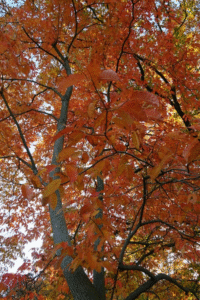Small trees are great choices for home landscapes. Compared to large canopy trees, small trees are less likely to interfere with overhead utility lines or rooftop solar panels. They make good street trees in tight spaces between the sidewalk and the curb. Ecologically, small trees add diversity, increasing food and habitat options for wildlife. Aesthetically, small trees won’t dominate a landscape or obstruct views from a house or patio. On the other hand, small trees can be part of a mixed privacy screen. And of course, many small trees have beautiful flowers, particularly in the spring.
Recommended Trees
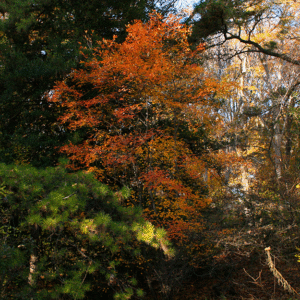
The following small trees are recommended for Virginia. Some are well-known, some not. This list is based on Charlottesville’s Comprehensive Tree List (under the “Powerline-compatible” tab), which also has useful information about shrubs, canopy trees, and trees that are not recommended. Further reading can be found in the References section below.
Native Trees:
- Serviceberry (15-25 feet high) Early white flowers, often grown as a multi-stemmed tree. Serviceberries are understory trees that grow best in part shade: 4-6 hours sunlight per day, preferably in the morning and early afternoon. There are 3 native serviceberry species in Virginia: downy, Allegheny, and Canadian. Downy serviceberries are the best choice for most locations because they’re somewhat drought-tolerant. Canadian serviceberries are better adapted to wet soils. Serviceberries’ flowers attract pollinators and develop into small dark blue edible fruits. Fall foliage is a beautiful red-orange. For more details, consult Piedmont Master Gardener Pat Chadwick’s article.
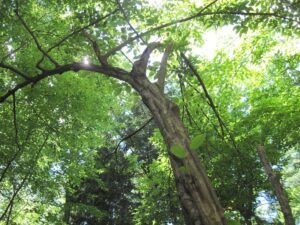
American hornbeam. Photo: Rob Duval. CC BY-SA 3.0 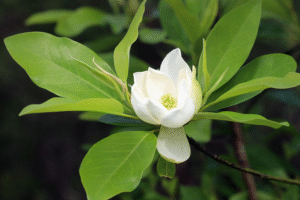
Sweet bay magnolia flower and leaves. Photo: Philip Bouchard. CC BY-NC-ND 2.0 - American hornbeam (20-35 feet high) Nicknamed “ironwood” because of its hard, dense wood, covered by smooth blue-gray bark. Also known as “musclewood” for the elongated bumps under the bark. Attractive dark green leaves turn brilliant red, yellow, and orange in the fall. Flowers aren’t showy but attract plenty of pollinators. As an understory tree, it grows well in heavy shade. Hornbeams prefer moist conditions and aren’t drought-tolerant. Transplant in the spring, not fall or winter.
- Sweet bay magnolia (10-35 feet high) A deciduous relative of the southern magnolia, its leaves are shiny and dark green above, gray-green and downy on the underside. Fragrant white flowers develop into cones with bright red berries that attract birds and small mammals. Sweet bay magnolias do well in full sun to part shade, and prefer moist soils. Often grown as a short multi-stemmed tree in mid-Atlantic states, and as a taller single-trunk tree farther south.
- Eastern redbud (20-30 feet high) Known for their early light purple flowers – which are edible – redbuds also have lovely smooth heart-shaped leaves that turn greenish yellow in fall. They’re good street trees that do well in full sun as well as shadier locations. Redbuds aren’t drought tolerant, so if planting in a hot, sunny spot, amend the soil with compost before planting and mulch well around – but not against – the trunk.
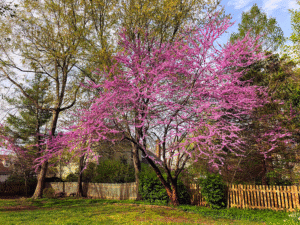
Eastern redbud in bloom. Picture (color adjusted): Famartin. CC BY-SA 4.0 - Sourwood (20-50 feet high) Foliage is sourwood’s main strength: long shiny green leaves turn a spectacular bright red in fall. It has attractive brown seedpods that remain on the tree all winter. Sourwoods grow well in full sun to part shade and can handle moderate drought once well-established. They require well-drained acidic soil, like rhododendrons and blueberries. They’re sensitive to air pollution, so don’t plant near the street. Young trees, less than 5 years old, transplant best.
- Flowering dogwood (15-30 feet high) These trees need no introduction, especially in Virginia, where it’s the official state tree. Flowers are white and/or pink, depending on the variety. Location is the key to a successful dogwood tree. In particular, dogwoods don’t do well in hot, sunny spots. Instead, plant dogwoods in partial shade in well-drained, moist, slightly acidic soil. Stressed trees are quite susceptible to diseases like powdery mildew and anthracnose. Some cultivars may have resistance to these conditions, so check the tag when purchasing.
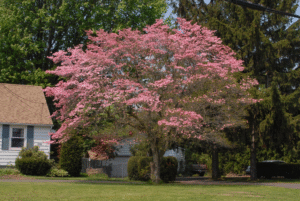
Flowering dogwood. Photo: Jim Robbins. CC BY-NC-ND 4.0
Non-native Trees:
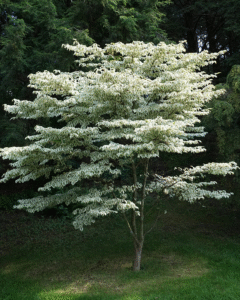
-
- Kousa (pronounced koo-sah) dogwood (15-30 feet high) Also called Korean, Japanese, Chinese, or Asian dogwood because of its origins in east Asia. Kousa dogwoods look much like flowering dogwoods, but flower a little later in the spring. Large red fruit can be eaten by humans. They’re a much better choice than flowering dogwoods for hot locations that get a lot of sun. They’re also more resistant to anthracnose and other fungal diseases than flowering dogwoods.
- Flowering cherry There are many kinds of flowering cherries, sometimes called ornamental, Japanese, Korean, or Asian cherries. (Flowering cherries are a different family of trees than our native black cherry, which is beautiful but quite large.) A few standout varieties:
- Yoshino cherries (30-40 feet high) make up the majority of the famous cherry trees along the Potomac River in Washington, DC. They have single white or pink-white flowers.
- Kwanzan cherries (25-30 feet high) are also common in Washington and have double pink blossoms. They bloom a little later than the Yoshinos; also called “Kanzan” and “Sekiyama.”
- Weeping cherries (30-50 feet high) have long branches that drop towards the ground. There are many cultivars with different colors and double or single blossoms. Also known as Higan cherries, named for a Buddhist holiday celebrated at the equinoxes.
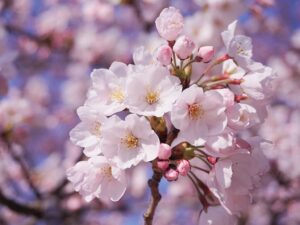
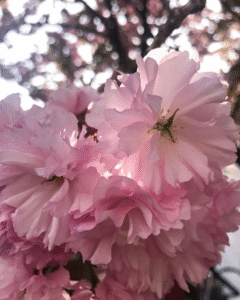
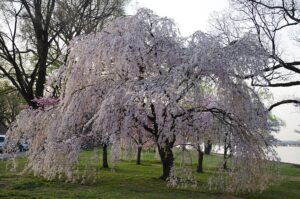
The National Park Service website has a nice summary of the cherry varieties found in Washington, DC.
Cherries need at least six hours of sun to make lots of flowers. Plant in well-drained soil. Even under the best of conditions, flowering cherries are susceptible to a lot of diseases and insect pests. The University of Maryland has written a comprehensive document about problems affecting cherry trees. Many issues can be avoided by keeping the leaves dry, so prune cherry trees to allow air flow through the canopy.
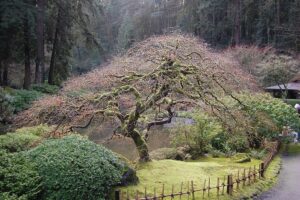
- Japanese Maple These graceful east Asian trees do best in partial shade, but some cultivars can handle full sun. There are many cultivars with differing leaf shapes and colors, from green to purple to patterns of white and green. Autumn color is usually very showy and can also vary widely: purple, red, yellow, yellow-green. Growth habit is usually upright, but weeping varieties are also available. Japanese maples do best in moist soil. They’re not very drought tolerant, so don’t plant them in dry or windy spots.
Planting
Most importantly, choose a good site to plant your tree. Characteristics to consider include soil moisture and drainage, amount of sun, and wind exposure. A soil test is always a good idea to ensure proper soil pH and nutrition levels. Our horticultural help desks can help to interpret soil test results and recommendations for amendments.
If you’re planting next to a house, don’t plant too close. The Arbor Day Foundation recommends planting small trees at least 8-10 feet from houses. This will help prevent roots from damaging the foundation. Also, even a small tree can look out of scale when it’s planted right up against a house.
Timing of planting is also important. For the most part, fall and winter are the best times to plant new trees because the roots are dormant and less susceptible to damage. A few trees, however, do better when planted in late winter or early spring. Check the nursery tag or reliable online resources.
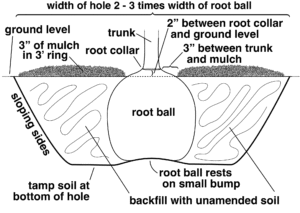
Here are a few tips for planting (the Charlottesville Area Tree Stewards have an excellent document and video with more detailed information): First, dig a circular hole with sloping sides as deep as the root ball and 2-3 times as wide (see picture). Tamp the soil at the bottom and pile a little soil in the center to make a bump about 2 inches high. Take the tree out of its pot and gently remove as much potting material as possible from around the roots. If the roots are wrapped in burlap, remove the burlap and any wires but leave the soil around the roots in place. Place the root ball in the hole and check that the root flare, where the roots transition into the trunk, is 2 inches above ground level. Add or remove soil at the bottom of the hole as needed. Backfill the hole with the excavated soil, spreading the roots out and adding water to improve contact between roots and soil. Do not add fertilizer or potting medium to the hole. Water the backfilled soil until it’s moist. Cover the backfilled area with 3 inches of hardwood mulch, leaving a 3 inch gap between the mulch and the trunk. Spread any potting medium on top of the mulch.

Care
Newly planted trees require water and protection. As mentioned above, water deeply right after planting. It shouldn’t be necessary to irrigate over the winter. Once it warms up, a rule of thumb is that a new tree needs an inch of water per week. Invest in a rain gauge, and if it hasn’t rained enough in the past week, dump a 5-gallon bucket of water around the tree. (One inch of rain is the equivalent of 4.4 gallons in a 3 foot diameter circle.) In particularly hot and dry weather, add a little more water. Mulch the soil around the tree to keep it moist.
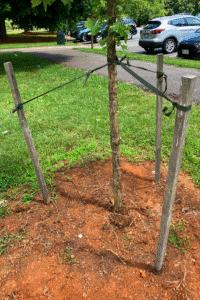
Protect new trees by caging and staking. If deer are common in your area, encircle new trees with 3- or 4-foot high wire fencing. As the tree gets taller, replace the cage with trunk protection: a corrugated plastic tube, UV-treated plastic mesh, or a spiral wrap. If the tree is in a windy spot, or if the trunk isn’t as straight as you’d like, hammer two or three stakes firmly in the ground and attach them to the trunk with wide fabric straps.
Closing thoughts
Winter is coming, though in August that might be hard to believe, and that means it’s time to think about planting trees. Look around your home landscape and ask yourself if a small tree or two might be good choices for certain spots – perhaps close (but not too close) to the house, or as part of an understory layer beneath a canopy tree. The benefits will be both aesthetic and ecological.
References and further reading
American hornbeam Missouri Botanical Garden
City of Charlottesville Comprehensive Tree List (Excel)
Eastern redbud Missouri Botanical Garden
Flowering dogwood Missouri Botanical Garden
Japanese Maple Missouri Botanical Garden
Kousa dogwood Missouri Botanical Garden
Kwanzan cherry Missouri Botanical Garden
Right tree, right place Arbor Day Foundation
Serviceberry Missouri Botanical Garden
Sourwood Missouri Botanical Garden
Sweet bay magnolia Missouri Botanical Garden
Tree planting guide (PDF) Charlottesville Area Tree Stewards
Tree planting video Charlottesville Area Tree Stewards
Trunk Protection (PDF) University of Minnesota
Yoshino cherry Missouri Botanical Garden
Weeping cherry Missouri Botanical Garden
Featured image: Karen Blaha. CC BY-SA 2.0 (cropped)
